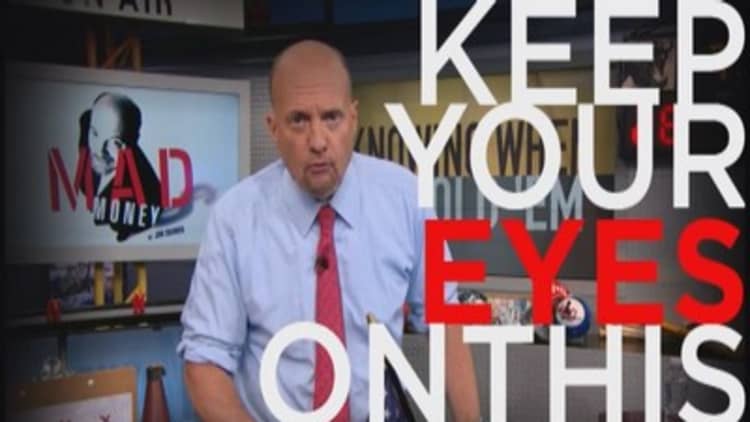
Even Jim Cramer doesn't get it right all the time. Frankly, when he looked back at his investment decisions over the past five years, he wanted to kick himself for missing a few important red flags.
One thing that the "Mad Money" host hates is that he didn't stick with some of his picks through a rough period, when homework suggested they were solid long-term winners.
Of course, a certain degree of skepticism is necessary to be an effective investor, but too much skepticism can do more harm than good.
"This is not just my opinion. I can prove it to you empirically. See, as I was preparing to write my book "Get Rich Carefully," I went over the previous five years of trades made by my charitable trust. And as I reviewed those trades I noticed that far too often, my good judgment would be overcome by excessive skepticism."
In the past, there were times when Cramer identified companies with solid balance sheets, good future potential and excellent management teams, yet he let skepticism prevail instead of trusting the research and his instincts.
Read More Self-critical, Cramer reveals big stock regret
The "Mad Money" host has learned to spot these red flags through his personal experience. One thing that he certainly learned the hard way is to stay true to his convictions.
"Hear me out before you change the channel," he said, "when you have done a lot of homework on a stock and you really believe in the company, don't lose your resolve just because that stock goes lower or because the nattering nabobs of negativity keep saying it's a sell. Instead, take a page from the Tom Petty playbook and don't back down."
When Cramer was writing his book, he took a look at all of the trades he had made over the years. One of the biggest blunders the Charitable Trust made was with Bed Bath & Beyond.
In 2012, Cramer decided to start a position in Bed Bath & Beyond when it was trading in the low $70s. But after a series of blah reports where the company didn't return ground-breaking earnings, and chatter from analysts that sales at the store were slowing down, Cramer got spooked and sold his position. Eventually, the stock began trading at $80 after he sold it.
"We should have had the courage to ride more of that wave than just the first few points, given the hard-fought way we'd approached it, and if we hadn't lost our nerve, Bed Bath would have been one of the trust's biggest gains for the year."
Another mistake that Cramer has learned from, is where to look for love in all the right places. No, he wasn't talking about anyone in particular. He was referring to "stealth tech" stocks.
That's not to say the cloud, or the PC refresh cycle or the demand for semiconductor chips aren't solid ideas. It is simply that Cramer believes tech plays can also be found in areas where you might not otherwise be inclined to look.
"When I talk about stealth tech, I'm referring to companies that are using proprietary technology," Cramer said. In turn, the technology allows the companies to either gain market share, win new business away from rivals or offer customers a preferred experience.
Examples of these tech plays include Domino's, with their online ordering system, and Colgate's ability to leverage technology in the use for whitening strips.
Another rule that has led Cramer to become a better investor is to set a bottom line to purchase stock.
"What's this rule? Simple: never buy any stock above your cost basis, or the average price you've paid to build up your current position, unless something truly transformative has happened at the company."
In other words, if you determine $25 is your buy price, and you scale into a full position at an average price of $25, but then your stock subsequently rallies to $30, don't increase the size of your position at $30, even if you think there's more upside ahead.
There is however, an exception to Cramer's cost basis rule. "It's okay to pay a higher price for a stock if something's changed at the company that makes you believe the stock could increase dramatically."
However if the stock is simply rallying with the rest of the market without a specific catalyst, then Cramer's rule remains solidly in effect.
Read More Cramer's draconian rule that really drives profits
Sometimes even a sell strategy is so obvious, Cramer can almost see you rolling your eyes, right through the TV.
After sifting through his own results and finding he wasn't always following this simple strategy himself, Cramer felt it had to be put into words, no matter what facial expressions may follow.
"The rule is very simple," Cramer said. "If you own a stock and it refuses to go higher when the market rallies over several days, you should probably sell it."
The rule seems so obvious, Cramer almost feels sheepish repeating it. But, it's a rule that could boost your bottom line significantly, and because it can do that, Cramer would shout it from the rooftops if necessary.
"For example, when PC stocks started to falter on big up days in 2008, it was an early sign that the space was facing something greater than a cyclical downswing," Cramer explained.
And even though some of these stocks had generated enormous gains, the strategic move was to sell.
"Ultimately the price action was a sign that smartphones were about to make PC's far less relevant," Cramer explained. Investors didn't know that at the time; but the lack of an advance on big up days telegraphed that something wasn't right.

